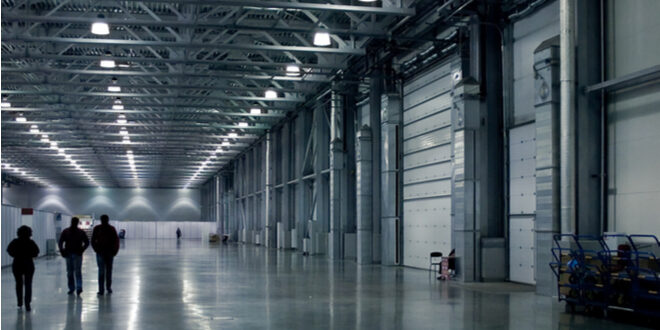The Inland Empire industrial market is in a slump.
After years of what appeared to be effortless growth, logistics in Riverside and San Bernardino counties has been slowing for at least six months, and it could be more than merely a long post-pandemic slowdown.
Vacancy is trending up, while net absorption, construction and lease rates are all moving down, according to Colliers’ first quarter report on the local industrial market.
Vacancy in the Inland industrial market has now outpaced net absorption for nine consecutive quarters, the report found.
Other brokerages were equally pessimistic. CBRE described “a continuation of negative trends” that included less development and declining fees during the first quarter, while Kidder Mathews noted “surging” vacancy rates and several closures of major Inland warehouse-distribution facilities.
“The market has seen minus-3.4 million square foot net absorption rate over the past 12 months and a decrease in asking rents for the first time in a decade, driven by a flood of discounted sublease space,” Kidder-Mathews’ first quarter report states.
The Inland industrial market is undergoing “significant changes” that might not end soon, the report concludes, and one local academic agrees.
“The Inland Empire is still one of the biggest industrial markets in the country, but there’s no question that is has slowed down,” said Manfred Keil, associate professor of economics at Claremont McKenna College. “It’s a major industrial market, but It’s not as strong as it was a couple of years ago.”
It’s now conventional wisdom that the Inland Empire, because it has so many warehouse-distribution families, was helped by the pandemic. Stores and restaurants shut down, people could not go out and shop or visit a restaurant, so they began shopping more online. That created more demand for warehouse space.
As a result, the Inland region sustained only a mild economic slowdown, one that lifted a few months after the pandemic began early in the spring of 2020. Now, the region might be paying a price for that good fortune four years ago.
“Look at the recovery we’ve had from the pandemic recession,” said Keil, who has been charting the Inland Empire economy for about 15 years. “The Inland Empire recovered by May 2020, which was a lot faster than California and the country as a whole recovered. California, and the United States, didn’t recover until the summer of 2022.”
In addition, consumers returned to their pre-pandemic spending habits quickly once the COVID-19 virus receded. That meant a lot of new warehouse-distribution space went unused, a particularly bad development for the Inland region.
“People in the logistics industry did not see that coming,” Keil said. “I don’t think they thought that would happen.”
Whatever the reason, the Inland industrial market – sometimes called the warehouse of the western United States – is struggling, and it’s not clear how long the slowdown will last.
Industrial vacancy reached 6.2 percent during the first quarter, the highest it’s been since 2013, according to Colliers.
In the first quarter of 2023, Inland industrial vacancy was 1.9 percent.
Net absorption in the first quarter of this year was minus 2.7 million square feet, down from 952,542 square feet in the previous quarter and 2,406,998 square feet year-over year. That was the ninth consecutive quarter that absorption fell short to new projects coming on the market, Colliers reported.
Twenty point seven million square feet of industrial construction occurred during the first quarter of 2024, down slightly from the fourth quarter of 2023 but down from 37 million square feet one year earlier.
Average lease rates were $1.40 per square foot, down eight cents from the previous quarter and down 23 cents year-over-year.
“With 20.7 million square feet of construction in the pipeline, vacancy will continue to climb,” the Colliers report predict.
Right now, the Inland industrial market is being hurt in part because of its inability to fill the demand for warehouse-distribution spaces of one million square feet and larger, said Eric Paulsen, regional president with Kidder Mathews.
“There aren’t as many projects of one million square feet as there used to be,” said Paulsen whose territory includes the Inland Empire. “We aren’t built out, but most of the land that can accommodate that size is in Calimesa, Banning and Beaumont.
“That’s affordable land, but it’s way out there and it’s hard to get at. Now, a lot of those bigger projects are going to Phoenix.”
Several other factors, starting with overregulation, are causing the Inland industrial market problems.
“There are a lot of regulations,” Paulsen said. “The industrial market has become a target for California’s climate warriors, and the (South Coast) Air Quality Management District is tracking trucks. Both of those things are starting to scare some people away.
“There’s also been a lot of consolidation, which has caused some businesses to go away, and that has reduced demand for industrial space.”
Add to those two factors the growing opposition to more logistics projects being built in the Inland Empire. Although relatively new, that movement has already led to Beaumont and Moreno Valley rejecting warehouse-distribution projects of 2.5 million and 1.3 million square feet, respectively.
It also led to AB 1000, introduced in February 2023 by Assemblywoman Eloise Reyes, D-Colton. The bill, which would place stronger restrictions on the development of logistics projects statewide, was pulled for further review in January before its first scheduled committee hearing.
However, that the bill was proposed at all – and that a revised version of it will probably be introduced – indicates that some communities believe the state legislature should put limits on logistics development.
The people calling for those restrictions are correct when they say that warehouse-distribution centers disrupt neighborhoods, and they’ve probably succeeded in scaring away some logistics development from the Inland region, according to Keil.
“Warehouse-distribution facilities do cause more noise, more pollution and more traffic,” Keil said. “Their opponents make some valid points, but the logistics industry provides employment, so I think we have to put up with those things.
“There are costs associated with everything, but there are also benefits.”
Regardless of what’s causing its current problems, the Inland region will remain a major industrial region.
“It’s easy to say, ‘the market is down,’ and it is,” Paulsen said. “But the Inland Empire is one of the strongest industrial markets in the world, and it’s very close to two of greatest ports in the world. It will come back.”
 IE Business Daily Business news for the Inland Empire.
IE Business Daily Business news for the Inland Empire.


